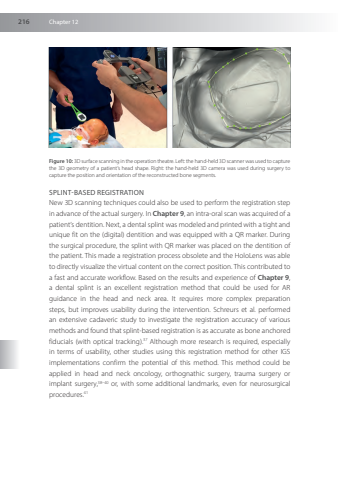Page 218 - Demo
P. 218
216Chapter12Figure103Dsurfacescanningin theoperation theatreLeft thehand-held3Dscanner wasused tocapturethe3Dgeometryofapatient’sheadshapeRightthehand-held3DcamerawasusedduringsurgerytocapturethepositionandorientationofthereconstructedbonesegmentsSPLINT-BASEDREGISTRATIONNew3Dscanningtechniquescouldalsobeusedtoperformtheregistrationstepinadvanceof theactualsurgeryInChapter9anintra-oralscanwasacquiredofapatient’sdentitionNextadentalsplintwasmodeledandprintedwithatightanduniquefitonthe(digital)dentitionandwasequippedwithaQRmarkerDuringthesurgicalprocedurethesplintwithQRmarkerwasplacedonthedentitionofthepatient ThismadearegistrationprocessobsoleteandtheHoloLenswasabletodirectlyvisualizethevirtualcontentonthecorrectposition ThiscontributedtoafastandaccurateworkflowBasedontheresultsandexperienceofChapter9adentalsplintisanexcellentregistrationmethodthatcouldbeusedforARguidanceintheheadandneckareaItrequiresmorecomplexpreparationstepsbutimprovesusabilityduringtheinterventionSchreursetalperformedanextensivecadavericstudytoinvestigatetheregistrationaccuracyofvariousmethodsandfoundthatsplint-basedregistrationisasaccurateasboneanchoredfiducials(withopticaltracking)37AlthoughmoreresearchisrequiredespeciallyintermsofusabilityotherstudiesusingthisregistrationmethodforotherIGSimplementationsconfirmthepotentialofthismethodThismethodcouldbeappliedinheadandneckoncologyorthognathicsurgerytraumasurgeryorimplantsurgery38–40or,withsomeadditionallandmarksevenforneurosurgicalprocedures41


